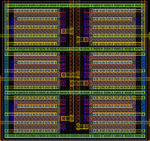preethi19
Full Member level 5

Hi i need to match 5 transistor (A,B,C,D,E) each having 2 fingers. So the total is 10. So 3x4=12.. So i add 2 dummies (0) and i have laid them as
D E 0
A B C
-------
A B C
D E 0
Is this a right way to do. Or should i make an even square matrix by adding 4x4=16... So by adding 6 dummies. Am i missing something??? Any tip while generally doing layout. Thanks!!!!
D E 0
A B C
-------
A B C
D E 0
Is this a right way to do. Or should i make an even square matrix by adding 4x4=16... So by adding 6 dummies. Am i missing something??? Any tip while generally doing layout. Thanks!!!!



